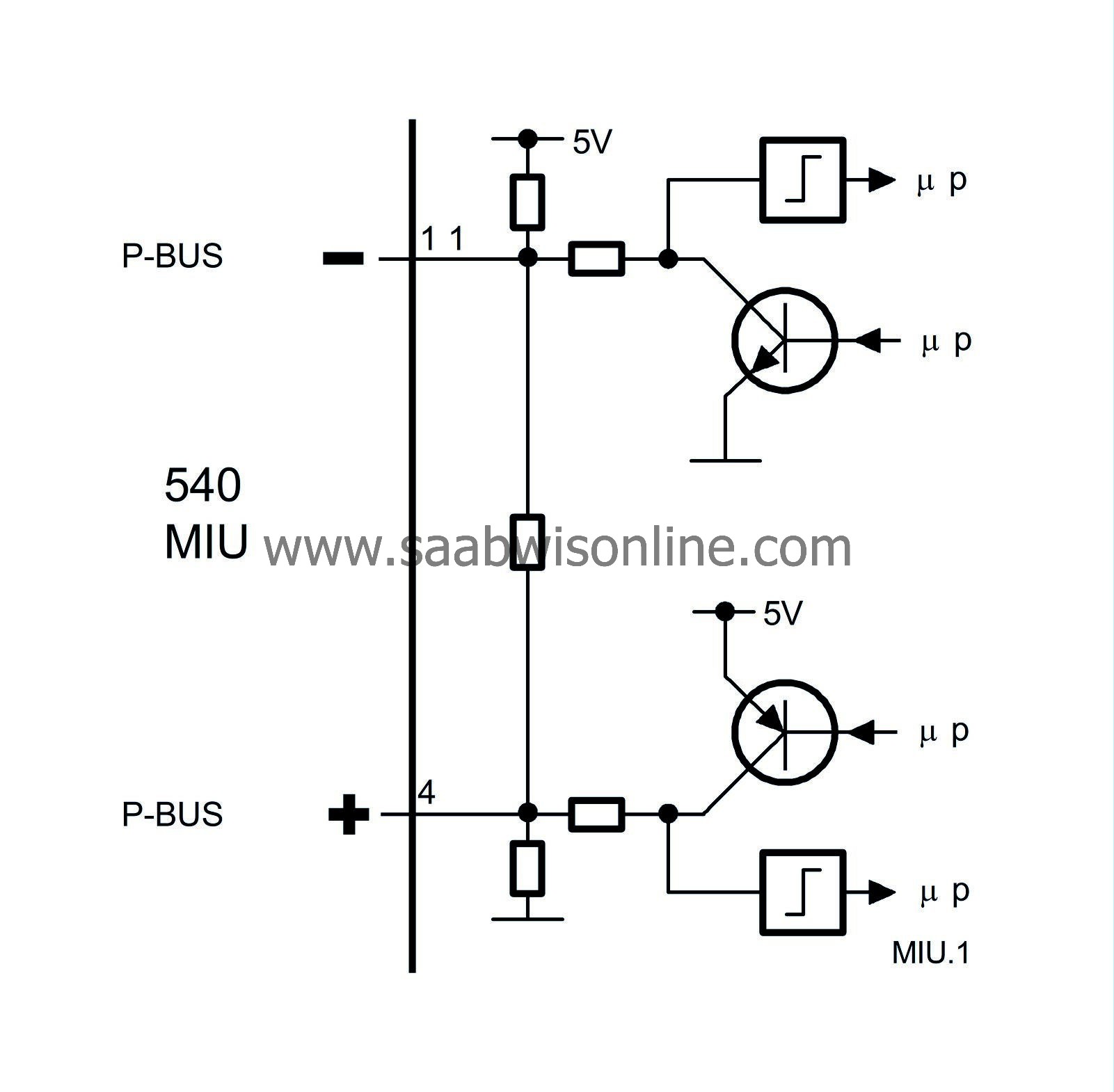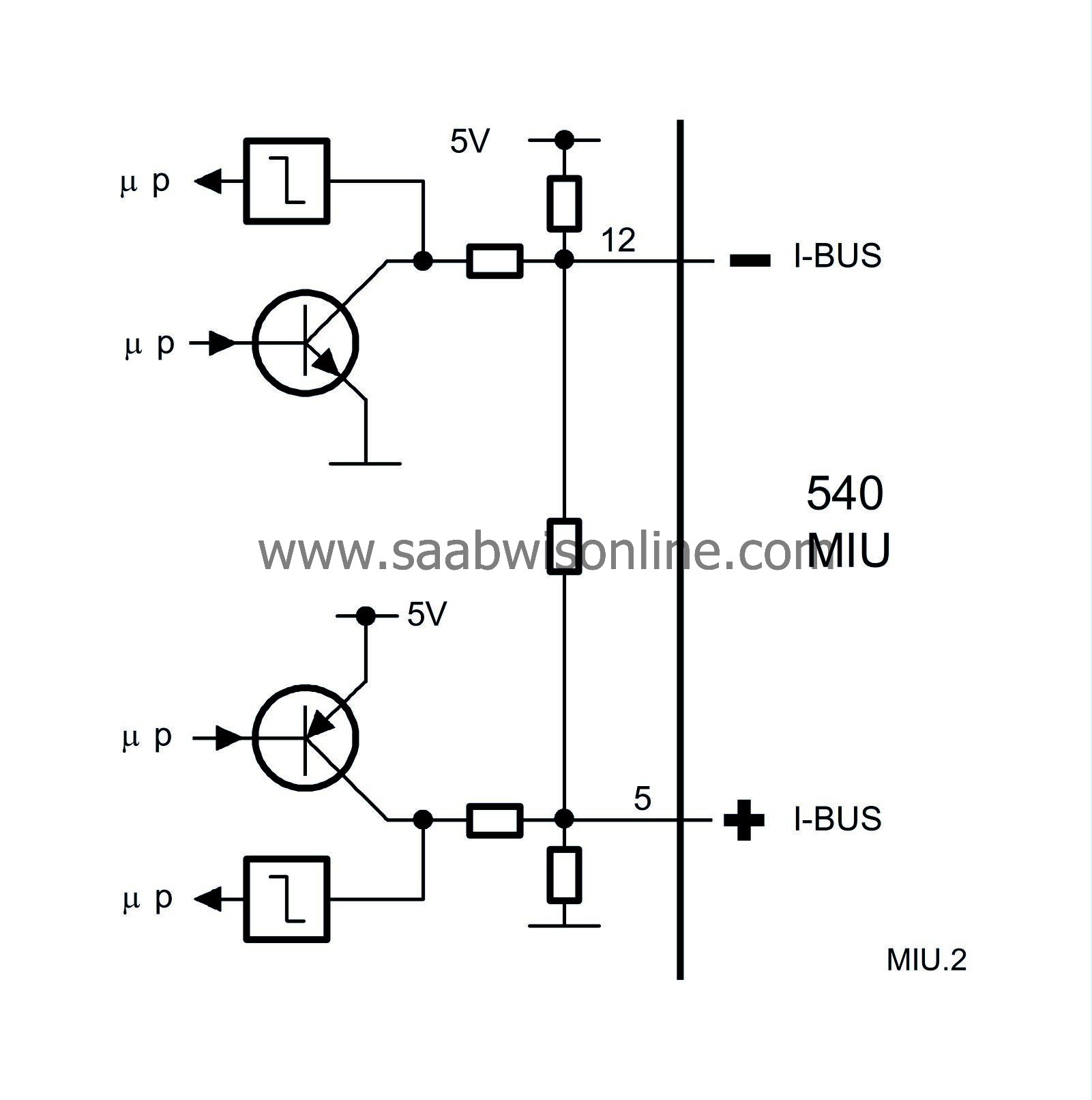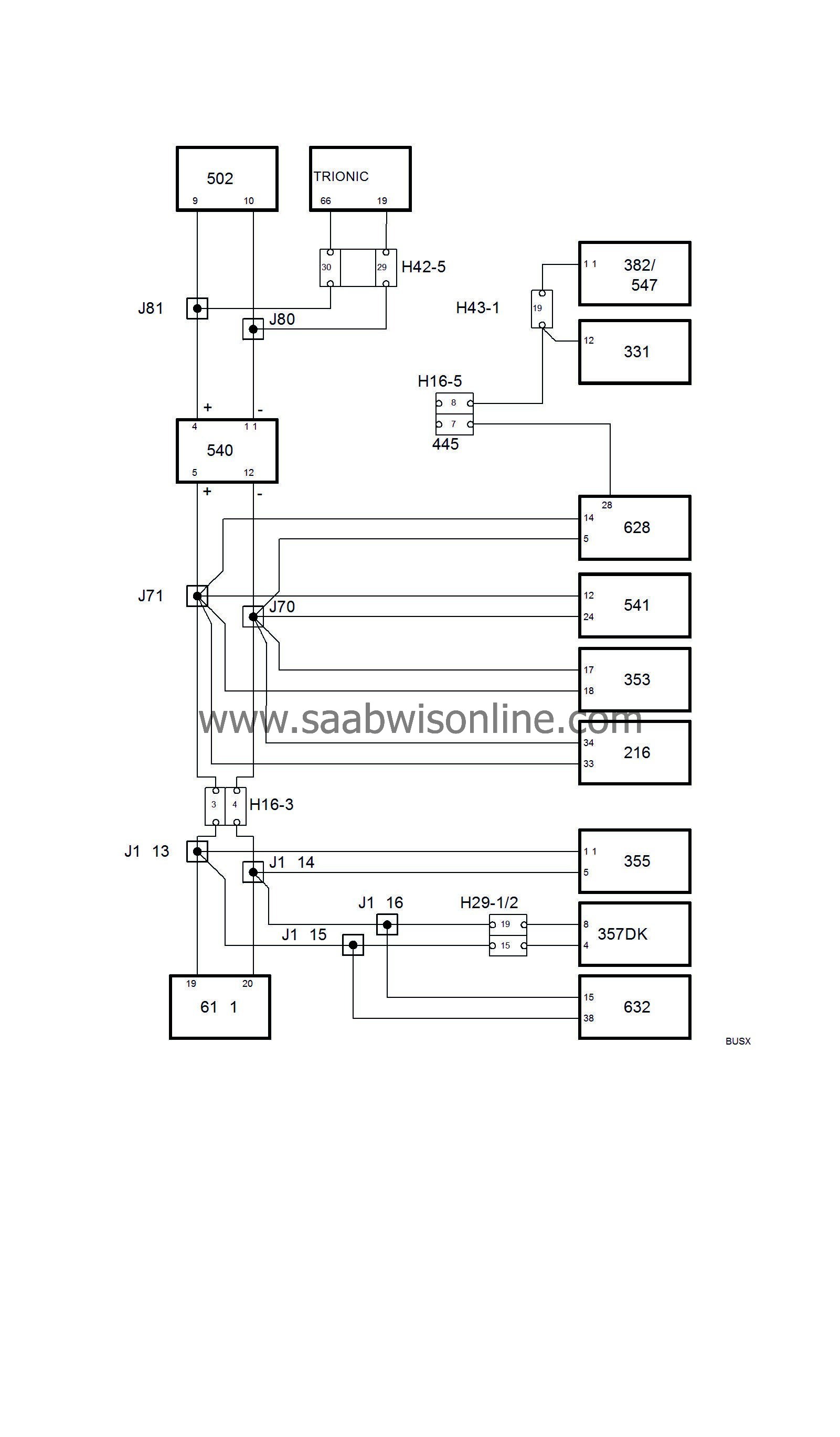Bus communication
| Bus communication |
| P-bus and I-bus |
All the control module in the Saab 9-5 are connected to the bus with the exception of the TC/ABS and SRS.
The bus is divided into a Powertrain bus (P-bus) and an Instrument bus (I-bus).
The data transfer rate on the P-bus is ten times faster than on the I-bus.
All the information sent from one control module is accessible for all the other control modules on the bus. The MIU ensures that the information which is available on one bus is also available to the other bus.
The control modules send information to the bus at regular intervals. The time between two transmissions depends on which information is being sent and varies between 10 milliseconds (0.010 seconds) and one second. The control module also sends information every time it changes.
Information is transmitted between control modules on two leads, BUS+ (green lead) and BUS- (white lead). Both P-bus leads are twisted to reduce their sensitivity to electrical interference.
On MIU connected to both the I-bus and the P-bus, the twisted leads are connected to the following pins of the 12-pin connector:


|
I-bus:
|
Pin 5 (green lead Bus+) Pin 12 (white lead Bus-)
|
|
P-bus:
|
Pin 4 (green lead Bus+) Pin 11 (white lead Bus-)
|
| Diagnostics |
In a bus system, all the units must be able to communicate with each other. For example, the engine cannot be started if Trionic is unable to receive immobilizer information from TWICE.
Permanent bus faults
All communication between the diagnostic tool and the bus-connected systems goes via DICE. Irrespective of which system is being contacted, the diagnostic tool and DICE will check to see that all the bus-connected systems in the car are activated and communicating. If any bus-connected control module is missing, the diagnostic tool will detect this. This means that all the bus-connected control modules are communicating correctly if there is no warning from the diagnostic tool.Intermittent bus faults
Trionic and TCM check continuously to see that all the control modules they receive information from are communicating correctly. In the event of an intermittent fault occurring in bus communication, a diagnostic trouble code will be set in Trionic and TCM. The cause of the fault could be that the power supply or one of the bus leads to the control module in question is absent.Incorrect values on the bus
Diagnostic trouble codes are set in Trionic and TCM if any information they receive from the bus has an incorrect value. The trouble code readout will refer to the faulty system.For further information on the bus, see 3:5 Diagnostics and bus communication .
| The MIU uses the following information: |
| Information | Unit | Sensor system | Description |
| LH direction indicators | On/Off | DICE | MIU turns on the repeater lamp for the LH direction indicator. |
|
RH direction indicators
|
On/Off
|
DICE
|
MIU turns on the repeater lamp for the RH direction indicator.
|
|
Rear fog light
|
On/Off
|
DICE
|
MIU turns on the indicator lamp for the rear fog lights.
|
|
Driver's door
|
OPEN/CLOSED
|
TWICE
|
MIU turns on the driver's door symbol.
|
|
Passenger's door
|
OPEN/CLOSED
|
TWICE
|
MIU turns on the passenger door symbol.
|
|
Rear door, LH
|
OPEN/CLOSED
|
TWICE
|
MIU turns on the LH rear door symbol.
|
|
Rear door, RH
|
OPEN/CLOSED
|
TWICE
|
MIU turns on the RH rear door symbol.
|
|
Tailgate
|
OPEN/CLOSED
|
TWICE
|
MIU turns on the boot lid symbol.
|
|
Info Disp Lamp
|
On/Off
|
SID
|
MIU turns on the Info Display indicator lamp.
|
|
Rheostat value
|
0-100 %
|
SID
|
Rheostat value.
|
|
Night Panel
|
On/Off
|
SID
|
MIU turns off certain instrument and display illumination.
|
|
Display lighting
|
0-100 %
|
SID
|
MIU uses the information to control the display illumination.
|
|
Brightness in cabin
|
LUX
|
SID
|
MIU uses the value to control the brightness of the indicator lamps.
|
|
Immobilizer
|
On/Off
|
TWICE
|
Immobilizer function
|
| Information | Unit | Sensor system | Description |
|
CHECK ENGINE Lamp
|
On/Off
|
Trionic
|
MIU turns on the CHECK ENGINE lamp.
|
|
CRUISE Lamp
|
On/Off
|
Trionic
|
MIU turns on the CRUISE lamp.
|
|
SHIFT UP lamp
|
On/Off
|
Trionic
|
MIU turns on the SHIFT-UP lamp.
|
|
Fuel Consumed Since Start
|
0-65535 ml
|
Trionic
|
Used by SID for the trip computer function, can be adjusted with an offset in MIU.
|
|
Engine speed
|
0-7000 rpm
|
Trionic
|
MIU controls the tachometer.
|
|
Coolant temperature
|
-40-215°C
|
Trionic
|
MIU controls the coolant temperature gauge
|
|
Selector lever position
|
P, R, N, D, 3, 2, 1
|
TCM
|
MIU turns on the indicator lamp concerned.
|
|
CHECK GEARBOX Lamp
|
On/Off
|
TCM
|
MIU turns on the CHECK GEARBOX lamp.
|
|
SPORT Lamp
|
On/Off
|
TCM
|
MIU turns on the SPORT lamp.
|
|
WINTER Lamp
|
On/Off
|
TCM
|
MIU turns on the WINTER lamp.
|
|
Diagnostics communication
|
DICE/Diagnostic tool.
|
||
|
Steering wheel location
|
LHD/RHD
|
TWICE
|
MIU turns on the driver's door/passenger door indicator.
|
| The MIU sends the following information: |
| Information | Unit | Used by | Description |
|
Vehicle speed
|
km/h (mph)
|
Trionic,
DICE, SID, ACC, Audio, TWICE |
The main instrument unit calculates the current vehicle speed based on the wheel speed information from the TC/ABS control module.
|
|
Sound
|
Acoustic information
|
SID
|
Request for acoustical signal when central warning lamp or Info Displ goes on.
|
|
Fuel level
|
litres
|
SID,
Trionic |
MIU sends information on the current fuel level in the tank.
|
|
Odometer reading
|
km (miles)
|
SID
|
Information on the distance driven
|
|
Diagnostics communication
|
DICE/Diagnostic tool.
|
||
|
Identification number
|
|
TWICE
|
Value created in MIU when immobilizer code is programmed in TWICE
|



